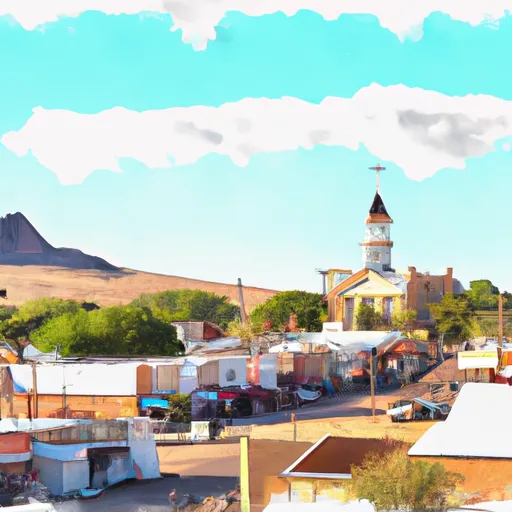-
 Snoflo Premium
Snoflo Premium
Get unlimited access to all our content
With no Ad interruptions! - Start Your Free Trial Login with existing account
Tombstone
Eden Index
Climate
9.0
•
Recreation
3.6
•
Community
2.3
•
Safeguard
5.4/10

Tombstone, Arizona is a historic town located in Cochise County. Known as "The Town Too Tough to Die," Tombstone is famous for its Wild West history and the legendary gunfight at the O.K. Corral.
Tombstone experiences a semi-arid climate characterized by hot summers and mild winters. Summers can be scorching with temperatures often reaching over 100 degrees Fahrenheit, while winters are generally mild with temperatures seldom dropping below freezing. The town receives very little rainfall, with an average annual precipitation of around 12 inches, mainly occurring during the summer monsoon season.
The hydrology constituents of Tombstone are influenced by its proximity to the San Pedro River, which flows nearby. The river provides a crucial water source for plants and wildlife in the surrounding desert ecosystem. Additionally, Tombstone relies on groundwater sources for its water supply.
Outdoor recreation opportunities in Tombstone are plentiful. Visitors can explore the town's rich history by visiting historic sites and museums, such as the O.K. Corral and the Tombstone Courthouse State Historic Park. The surrounding area offers opportunities for hiking, bird-watching, and wildlife viewing in the nearby Coronado National Forest and the San Pedro Riparian National Conservation Area. Additionally, Tombstone is a gateway to the scenic Sonoran Desert and offers various off-road and ATV trails for outdoor enthusiasts to enjoy.
What is the Eden Index?
The Snoflo Eden Index serves as a comprehensive rating system for regions, evaluating their desirability through a holistic assessment of climate health, outdoor recreation opportunities, and natural disaster risk, acknowledging the profound impact of these factors on livability and well-being.
Climate Health Indicator (CHI): 9.0
Tombstone receives approximately
333mm of rain per year,
with humidity levels near 53%
and air temperatures averaging around
18°C.
Tombstone has a plant hardyness factor of
9, meaning
plants and agriculture in this region tend to thrive here all year round.
By considering the ideal temperature range, reliable water supplies, clean air, and stable seasonal rain or snowpacks, the Climate Health Indicator (CHI) underscores the significance of a healthy climate as the foundation for quality living.
A healthy climate is paramount for ensuring a high quality of life and livability in a region, fostering both physical well-being and environmental harmony. This can be characterized by ideal temperatures, reliable access to water supplies, clean air, and consistent seasonal rain or snowpacks.
Weather Forecast
Streamflow Conditions
San Pedro-Willcox
Area Rivers
San Pedro-Willcox
Snowpack Depths
San Pedro-Willcox
Reservoir Storage Capacity
San Pedro-Willcox
Groundwater Levels
Recreational Opportunity Index (ROI): 3.6
The Recreational Opportunity Index (ROI) recognizes the value of outdoor recreational options, such as parks, hiking trails, camping sites, and fishing spots, while acknowledging that climate plays a pivotal role in ensuring the comfort and consistency of these experiences.
Access to outdoor recreational opportunities, encompassing activities such as parks, hiking, camping, and fishing, is crucial for overall well-being, and the climate plays a pivotal role in enabling and enhancing these experiences, ensuring that individuals can engage in nature-based activities comfortably and consistently.
Camping Areas
| Campground | Campsites | Reservations | Toilets | Showers | Elevation |
|---|---|---|---|---|---|
| Cochise Stronghold | 10 | 4,948 ft |
Nearby Ski Areas
Catastrophe Safeguard Index (CSI):
The Catastrophe Safeguard Index (CSI) recognizes that natural disaster risk, encompassing floods, fires, hurricanes, and tornadoes, can drastically affect safety and the overall appeal of an area.
The level of natural disaster risk in a region significantly affects safety and the overall livability, with climate change amplifying these risks by potentially increasing the frequency and intensity of events like floods, fires, hurricanes, and tornadoes, thereby posing substantial challenges to community resilience and well-being.
Community Resilience Indicator (CRI): 2.3
The Community Resilience Indicator (CRI) recognizes that education, healthcare, and socioeconomics are crucial to the well-being of a region. The CRI acknowledges the profound impact of these elements on residents' overall quality of life. By evaluating educational resources, healthcare accessibility, and economic inclusivity, the index captures the essential aspects that contribute to a thriving community, fostering resident satisfaction, equity, and social cohesion.

